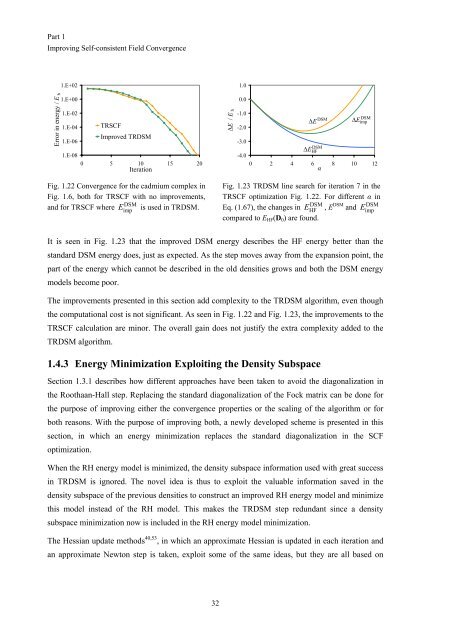Get my PhD Thesis
Get my PhD Thesis
Get my PhD Thesis
You also want an ePaper? Increase the reach of your titles
YUMPU automatically turns print PDFs into web optimized ePapers that Google loves.
Part 1<br />
Improving Self-consistent Field Convergence<br />
Error in energy / E h<br />
1.E+02<br />
1.E+00<br />
1.E-02<br />
1.E-04<br />
1.E-06<br />
1.E-08<br />
TRSCF<br />
Improved TRDSM<br />
0 5 10 15 20<br />
Iteration<br />
Fig. 1.22 Convergence for the cadmium complex in<br />
Fig. 1.6, both for TRSCF with no improvements,<br />
and for TRSCF where E is used in TRDSM.<br />
DSM<br />
imp<br />
∆E / E h<br />
1.0<br />
0.0<br />
-1.0<br />
-2.0<br />
-3.0<br />
-4.0<br />
DSM<br />
∆E<br />
DSM<br />
∆E HF<br />
DSM<br />
∆E imp<br />
0 2 4 6 8 10 12<br />
α<br />
Fig. 1.23 TRDSM line search for iteration 7 in the<br />
TRSCF optimization Fig. 1.22. For different α in<br />
DSM<br />
Eq. (1.67), the changes in E<br />
HF<br />
, E DSM DSM<br />
and E<br />
imp<br />
compared to E HF (D 0 ) are found.<br />
It is seen in Fig. 1.23 that the improved DSM energy describes the HF energy better than the<br />
standard DSM energy does, just as expected. As the step moves away from the expansion point, the<br />
part of the energy which cannot be described in the old densities grows and both the DSM energy<br />
models become poor.<br />
The improvements presented in this section add complexity to the TRDSM algorithm, even though<br />
the computational cost is not significant. As seen in Fig. 1.22 and Fig. 1.23, the improvements to the<br />
TRSCF calculation are minor. The overall gain does not justify the extra complexity added to the<br />
TRDSM algorithm.<br />
1.4.3 Energy Minimization Exploiting the Density Subspace<br />
Section 1.3.1 describes how different approaches have been taken to avoid the diagonalization in<br />
the Roothaan-Hall step. Replacing the standard diagonalization of the Fock matrix can be done for<br />
the purpose of improving either the convergence properties or the scaling of the algorithm or for<br />
both reasons. With the purpose of improving both, a newly developed scheme is presented in this<br />
section, in which an energy minimization replaces the standard diagonalization in the SCF<br />
optimization.<br />
When the RH energy model is minimized, the density subspace information used with great success<br />
in TRDSM is ignored. The novel idea is thus to exploit the valuable information saved in the<br />
density subspace of the previous densities to construct an improved RH energy model and minimize<br />
this model instead of the RH model. This makes the TRDSM step redundant since a density<br />
subspace minimization now is included in the RH energy model minimization.<br />
The Hessian update methods 40,53 , in which an approximate Hessian is updated in each iteration and<br />
an approximate Newton step is taken, exploit some of the same ideas, but they are all based on<br />
32

















